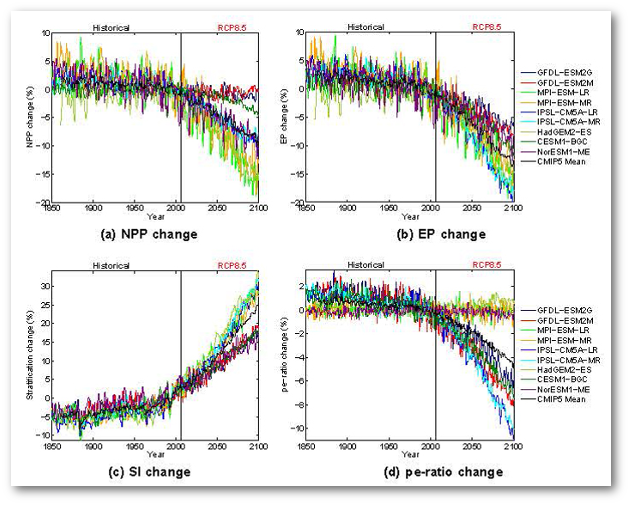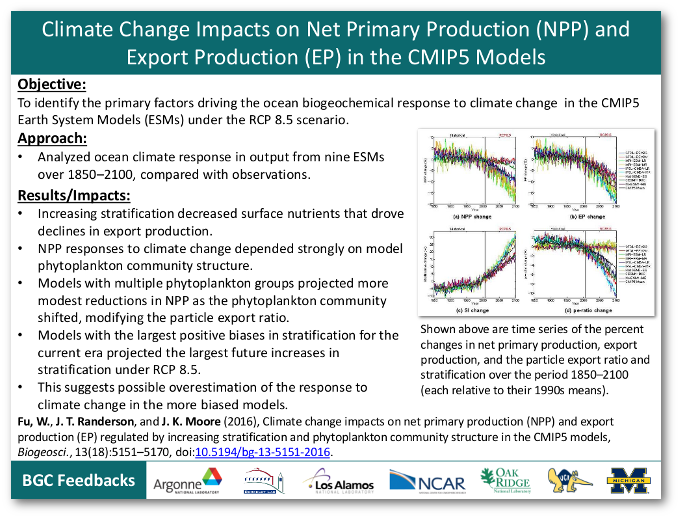Research Highlights
Climate change impacts on net primary production (NPP) and export production (EP) in the CMIP5 models
September 16, 2016
The Science
Researchers at the University of California Irvine analyzed the ocean response to changing climate in output from nine CMIP5 ESMs over the 1850–2100 period and found that increasing stratification decreased surface nutrients, driving declines in export production. NPP responses to climate change depended strongly on model phytoplankton community structure. Models with multiple phytoplankton groups projected more modest reductions in NPP as the phytoplankton community shifted, modifying the particle export ratio. Models with the largest positive biases in stratification for the current era projected the largest future increases in stratification under RCP 8.5.
The Impact
The fact that the models with the largest positive biases in stratification for the current era projected the largest future increases in stratification under RCP 8.5 suggests possible overestimation of the response to climate change in the more biased models.
Summary
We examined climate change impacts on net primary production (NPP) and export production (sinking particulate flux; EP) with simulations from nine Earth system models (ESMs) performed in the framework of the fifth phase of the Coupled Model Intercomparison Project (CMIP5). Global NPP and EP were reduced by the end of the century for the intense warming scenario of Representative Concentration Pathway (RCP) 8.5. Relative to the 1990s, NPP in the 2090s was reduced by 2–16% and EP by 7–18%. The models with the largest increases in stratification (and largest relative declines in NPP and EP) also showed the largest positive biases in stratification for the contemporary period, suggesting overestimation of climate change impacts on NPP and EP. All of the CMIP5 models showed an increase in stratification in response to surface–ocean warming and freshening, which was accompanied by decreases in surface nutrients, NPP and EP.
There was considerable variability across the models in the magnitudes of NPP, EP, surface nutrient concentrations and their perturbations by climate change. The negative response of NPP and EP to increasing stratification reflected primarily a bottom-up control, as upward nutrient flux declines at the global scale. Models with dynamic phytoplankton community structure showed larger declines in EP than in NPP. This pattern was driven by phytoplankton community composition shifts, with reductions in productivity by large phytoplankton as smaller phytoplankton (which export less efficiently) were favored under the increasing nutrient stress. Thus, the projections of the NPP response to climate change were critically dependent on the simulated phytoplankton community structure, the efficiency of the biological pump and the resulting levels of regenerated production, which varied widely across the models. Community structure was represented simply in the CMIP5 models, and should be expanded to better capture the spatial patterns and climate-driven changes in export efficiency.
Objective
To identify the primary factors driving the ocean biogeochemical response to climate change in the CMIP5 Earth System Models (ESMs) under the RCP 8.5 scenario.
Approach
Analyzed ocean climate response in output from nine ESMs over 1850–2100, compared with observations.
 |
Shown above are time series of the percent changes in net primary production, export production, and the particle export ratio and stratification over the period 1850–2100 (each relative to their 1990s means). |
Results/Impacts
- Increasing stratification decreased surface nutrients that drove declines in export production.
- NPP responses to climate change depended strongly on model phytoplankton community structure.
- Models with multiple phytoplankton groups projected more modest reductions in NPP as the phytoplankton community shifted, modifying the particle export ratio.
- Models with the largest positive biases in stratification for the current era projected the largest future increases in stratification under RCP 8.5.
- This suggests possible overestimation of the response to climate change in the more biased models.
Fu, Weiwei, James T. Randerson, and J. Keith Moore. September 16, 2016. “Climate Change Impacts on Net Primary Production (NPP) and Export Production (EP) Regulated by Increasing Stratification and Phytoplankton Community Structure in CMIP5 Models.” Biogeosci., 13(18):5151–5170. doi:10.5194/bg-13-5151-2016.
